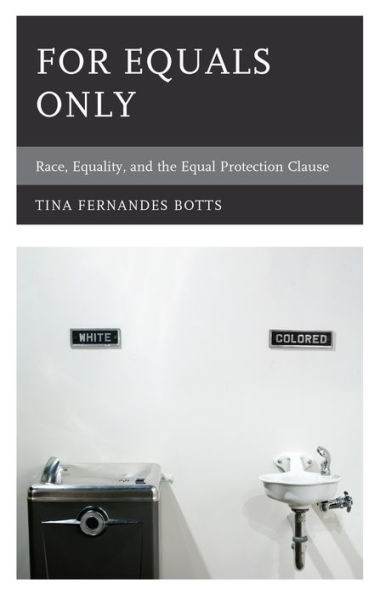5
1

For Equals Only: Race, Equality, and the Equal Protection Clause
142
by Tina Fernandes Botts
Tina Fernandes Botts

For Equals Only: Race, Equality, and the Equal Protection Clause
142
by Tina Fernandes Botts
Tina Fernandes Botts
Hardcover
$111.00
-
PICK UP IN STORECheck Availability at Nearby Stores
Available within 2 business hours
Related collections and offers
111.0
In Stock
Overview
This book philosophically explores how changing conceptions of race and equality have affected Supreme Court interpretations of the Equal Protection Clause of the 14th Amendment to the U.S. Constitution over the years. In the years since the 14th Amendment was ratified in 1868, in its decisions interpreting the Equal Protection Clause, the Supreme Court has switched from using a sociocultural concept of race to using a biological concept of race, and during the same time period has switched from using a social to a legal concept of equality. One result of these trends is the recent emergence of something called 'reverse discrimination.' Another result is that the Equal Protection Clause no longer specially protects racialized persons from racial discrimination, as it was originally intended to do. Using the tools of legal hermeneutics, critical philosophy of race, and critical race theory, key cases of racial discrimination in equal protection law are examined through a historical lens. The Supreme Court’s switch, over the years, from interpreting the Equal Protection Clause as specially protecting racialized persons from continued racial discrimination after the end of the institution of chattel slavery, to interpreting the Clause as protecting everyone from racial discrimination, is tracked alongside changing conceptions of race and equality. As the concept of race became biological, the concept of equality became legal, and the result was the elimination of remedying the negative effects of chattel slavery on the equality status of racialized persons from the Supreme Court’s list of priorities.

Product Details
| ISBN-13: | 9781498501231 |
|---|---|
| Publisher: | Lexington Books |
| Publication date: | 09/15/2018 |
| Series: | Philosophy of Race |
| Pages: | 142 |
| Product dimensions: | 6.10(w) x 9.10(h) x 0.60(d) |
About the Author
Tina Fernandes Botts is assistant professor of philosophy at California State University, Fresno.
Table of Contents
IntroductionChapter SummariesChapter 1: Scholarly BackdropLegal HermeneuticsCritical Philosophy of RaceCritical Race TheoryOrigins: The Work of Derrick BellCritical Race Theory and EqualityChapter 2: Equal Protection and Racialized PersonsThe Rise of Separate But Equal DoctrineWhat is Equal Protection?Racial Discrimination Per Se Begins: Japanese Americans after WWIISocial SegregationSeparate as InferiorSeparate But Equal OverturnedRacial Classifications and MarriageDiscriminatory Intent vs. Discriminatory ImpactBakke: Racial Discrimination Per Se is FormalizedPost-Bakke Fall-OutConcluding ReflectionsChapter 3: The Concept of Race and Equal Protection LawThe Supreme Court’s Switch from Sociocultural/Sociohistorical Race to Biological RaceThe Academic Switch from Biological Race to Sociocultural/Sociohistorical RaceA Change in Understanding of the Problem of Racial DiscriminationConcluding ReflectionsChapter 4: The Concept of Equality and Equal Protection LawEarly Equal Protection Law: Social EqualityContemporary Equal Protection Law: Legal EqualityLegal Equality is Out of Step with the Purpose of the ClauseHistorical ContextLegislative HistoryLegal Equality is Out of Step with the Contemporary Sociocultural ContextLegal Equality Facilitates and Perpetuates the Problem of Racial InequalityConcluding ReflectionsChapter 5: The Special Case of Multiracial Racialized PersonsHistorical Engagement Between Multiracial Racialized Persons and the LawAntimiscegenation LawsJim Crow Laws and SegregationThe “One Drop” RuleThe Failure of Antidiscrimination Laws to Protect Multiracial Racialized PersonsBiological RacesRacial Discrimination Perpetuates Historically Situated OppressionToward a Distinctive Multiracial Group IdentityAn Additional Modification to Antidiscrimination LawConcluding ReflectionsChapter 6: Thoughts Moving ForwardFrom the B&N Reads Blog
Page 1 of
